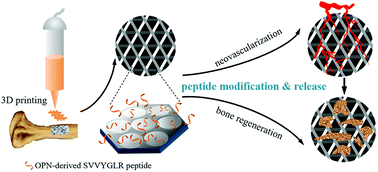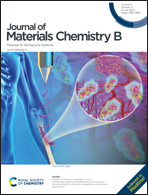Osteopontin sequence modified mesoporous calcium silicate scaffolds to promote angiogenesis in bone tissue regeneration
Abstract
Sufficient blood supply remains the key issue to be addressed for an optimal performance of implanted bone tissue engineering scaffolds. Host vessel invasion is limited to a depth of only several hundred micrometers from the scaffold/host interface. In this study, an osteopontin sequenced polypeptide SVVYGLR was grafted into/onto mesoporous calcium silicate (MCS) and then 3D-printed into scaffolds. The peptide motifs can be accessed on the scaffold surfaces and released as well. In vitro studies of human umbilical vein endothelial cells (HUVECs) indicated enhanced cell adhesion and vascular-like structure formation on MCS-SVVYGLR scaffolds. At the same time, human bone marrow stromal cells (hBMSCs) showed enhanced osteogenic differentiation capability and higher expression levels of angiogenic genes and proteins as well. The results of in vivo radial defect repair tests of rabbits showed that more tubular vessels formed throughout the whole MCS-SVVYGLR scaffolds, and therefore, a more homogeneous new bone formation pattern was obtained on MCS-SVVYGLR scaffolds instead of a peripheral bone growth pattern on pure MCS scaffolds by Micro-CT and tissue staining techniques over 3 months. Relative gene and protein expressions in PI3K/AKT and ERK1/2 pathways suggested that the SVVYGLR motif on the MCS scaffold surface could initiate the PI3K/AKT signaling pathway and up-regulate ERK1/2 expression, which positively stimulated VEGF expression, to improve angiogenesis.

- This article is part of the themed collection: Editor’s Choice: Tissue Engineering


 Please wait while we load your content...
Please wait while we load your content...